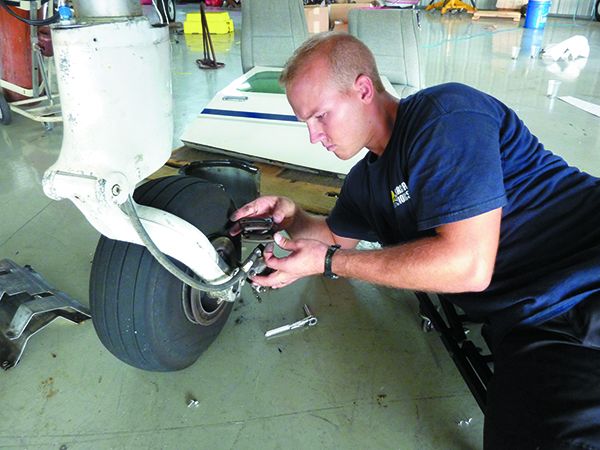If you do it right, they say, you may never have to touch the brakes while landing. But it seldom happens that way, and that’s why tires and brakes take a beating. We lock the brakes, we ride them, we overheat them. And the chain reaction—at best—means premature brake wear. At the worst, it’s a runway overrun or loss of control.
The proper preflight inspection can help you spot some trouble areas—if you know what you’re looking for—but there’s more to it. Here’s a primer for keeping tabs on brake wear in between visits to the shop, and a solid review on how they work.
STOPPING POWER EXPLAINED
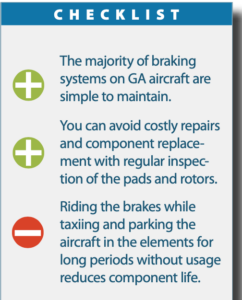
As simple as they are, aircraft braking systems have come a long way since the early days of aviation. While toe brakes eventually became the standard (a pilot’s toes proved to be better able to modulate pedal pressure), main-gear wheel brakes went through numerous iterations including drums, expander tubes and, best of all, hydraulic disks.
The Cleveland line of wheels and brakes became the gold standard for general aviation several decades ago. The company was ultimately bought out by Parker Aerospace, which kept the Cleveland name alive, and now accounts for the majority of the wheels and brakes installed on general aviation airplanes. There are other high-quality and high-tech choices, including French-made Beringer brakes and wheels. More on them in a minute.
In a typical general aviation airplane—and somewhat simplified—pressing on the toe brake moves a mechanical linkage connected to the master cylinder and pushes a piston inside the master cylinder to increase pressure on the hydraulic fluid stored inside the sealed cylinder. The fluid pressure increase is transmitted through lines to the brake assembly on the landing gear wheel.
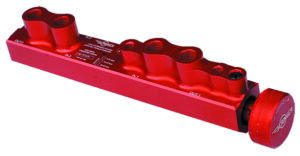
When the pilot removes pressure from the toe brake, a spring pushes the piston back to the full off position, which allows the fluid that was pushed into the brake assembly to be pulled back toward the brake master cylinder. A compensating mechanism in the master cylinder also helps ensure that any excess fluid goes to the right place (the fluid reservoir) so that the brake doesn’t drag or, worse, lock up.
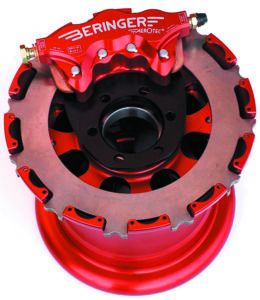
Most general aviation airplanes have single-disk brakes, while heavier airplanes use multiple-disk systems. In a single-disk system, the brake works by applying friction to both sides of a rotating disk that is attached to the main landing gear wheel. (The idea is to convert kinetic energy to heat.)
Steel has proven to be the best all-around metal for absorbing heat for maximum braking. There is a brake lining (or pad or puck) in the caliper/brake housing, positioned on either side of the brake disk. The inboard brake lining is stationary—riveted to the back plate of the brake housing. The caliper also contains a piston or pistons in cylinders, which are used to move the outboard brake linings. Hydraulic pressure from the brake master cylinder enters the brake cylinder and forces the piston toward the disk, pushing the brake lining on that side of the caliper against the disk. The disk is free to move laterally, so it is pressed against the inboard brake lining by the outboard brake lining, creating the friction required for braking.
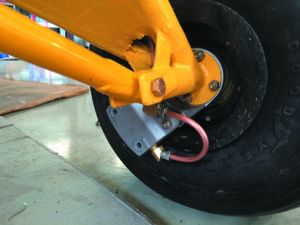
When pressure on the brake pedal is removed and the spring in the master cylinder pushes the piston in the master cylinder back to the off position, hydraulic pressure against the brake piston is removed and a return spring or springs move the brake piston back to the off position so the brake doesn’t drag. There is a self-adjusting mechanism and pin in the brake cylinder, so that as the brake linings wear, the piston travel is adjusted so that the same travel of the piston is always required to apply the brake.
PERFORMANCE
Brakes don’t feel right? Air in the brake lines will compress, which does anything from making brakes spongy and braking action unpredictable, to making them not work at all. A brake bleeder valve is installed on the brake housing so that air can be bled from the system.
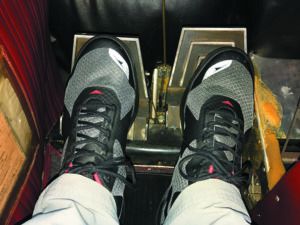
Some brakes simply grab better than others by nature of the components. Brake linings are organic—originally asbestos—but now usually Kevlar impregnated with various metals—or metallic. Organic linings are used for lighter weight airplanes. It’s easy to tell which is which—organic linings have holes in them for the rivets that mount them on the calipers; metallic do not, and they are mounted to a metal backing plate with pins.
Because of concerns with corrosion of steel brake disks (corrosion pitting speeds the wear of brake linings and reduces braking effectiveness) different metals have been tried. Stainless steel is used as well, but it has only half the ability to absorb heat as steel. It’s not uncommon for brake disks to be chromed to fight corrosion, but the chrome eventually wears through and the exposure returns. At least one supplier offers a nickel-plating of the disk, but it degrades brake effectiveness, so it is removed from the portion of the disk swiped by the brake linings after the plating process.
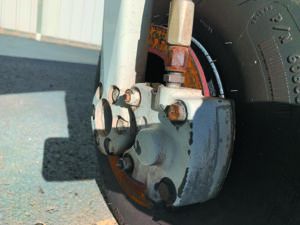
Certification of braking systems involves a calculation as to the heat energy that has to be created to stop the airplane in slightly over 10 seconds. Testing then involves putting the system designed from those calculations on a dynamometer test stand and demonstrating that the system can make the required 10- to 12-second stop 100 times (the brakes are allowed to cool after each stop), while changing brake pads no more than once.
In terms of the energy required to make a 10- to 12-second stop, Grove Aircraft owner Robbie Grove guided us through a calculator on the company’s website that showed that for a Cessna 210 touching down at a weight of 3500 pounds and starting to apply the brakes at 55 knots, each brake would have to absorb over 243,000 foot-pounds of kinetic energy. It’s said that nosewheel airplanes without nosewheel steering must have brakes that have 50 percent more capacity than those with nosewheel steering, although that is still lighter than a nosewheel steering mechanism.
Retained heat is the enemy of brakes—the brakes have to create heat, but they also have to shed it. As the lining heats up, it loses its effectiveness. For modern disk brakes, that’s usually not a problem as even hard braking to slow to taxi speed will still allow plenty of brake effectiveness when taxiing in, unless the pilot is one of those who taxis at 1300 RPM while riding the brakes. However, heat can be a problem for nosewheel airplanes that don’t have nosewheel steering at airports where it’s necessary to taxi a long way.
BRAKE MAINTENANCE
We know from experience that the majority of major brake repairs often come about because owners simply ignore the hardware that’s under the wheelpants—they too often wait for something serious to show up, such as a leak or complete failure. Just like in the automotive and motorcycle world, it’s much cheaper to replace worn brake pads than to have to do repairs and component replacement because the pads wore out and metal-on-metal wear wrecked the disk and parts of the caliper.
And look for signs of leaking brake fluid. The brake system can correct for small fluid leaks through a compensating port in the master cylinder. It will route brake fluid in from the reservoir for as long as the fluid lasts.
That means that a part of the pilot’s preflight should be to check for leaks in the parts of the brake lines that can be seen, as we’ll as for any drips or puddles underneath the brake assemblies. If there is any fluid noticed, the brakes should be checked and any repairs made before the next flight. It’s pretty simple: If the brake runs out of fluid, it’s not going to work.
CHECK THE BRAKES, PLEASE
If you pay a shop to do your oil changes, add some more to have them inspect the brake pads at the same time. This inspection interval is generally plenty to keep tabs on pad thickness, while also looking carefully at the calipers and lines for damage. Brake components on aircraft that sit for long periods in the elements are prone to premature corrosion, which is easy to spot during an inspection, although it may be difficult to do a thorough inspection with some wheel pants and fairings in place. It’s worth the effort to remove them periodically for a look-see.
There are no wear indicators for brake pads. Minimum thickness for aircraft brake pads is generally 0.100 inch. However, the service manual for the particular type of brake is the final authority. Waiting too long is when the trouble begins. Once the linings are worn below limits, there will be metal-to-metal contact between either the steel rivets of organic linings or the metal backing plate and pins of metallic lines and the brake disk. (We like that Grove Aircraft brakes smartly use brass rivets that will not damage steel brake disks.) The steel-to-steel contact will rapidly start to erode the disk. While linings are roughly $40 each, a disk might cost we’ll north of $200 for something the size of a Cessna 172. It’s just foolish to tear up a disk because of a delay in replacing linings. But that may not be the end of the damage.
That’s because the brake piston is designed for use with a brake pad that is within tolerances. Once the pad is worn below tolerances, the piston will extend too far, potentially leading to a brake fluid leak. Worse, its O-ring may come out of the caliper, which will result in a massive brake fluid leak and brake failure.
And don’t underestimate the damage that lack of use can induce. Non-usage allows the glaze on the brake pads to break down. When brake linings are replaced, there is a conditioning process required, which a good brake tech will take the time to accomplish. It involves hard stops from a fast taxi, and it imparts the glaze to the linings that is important to good braking action. When the glaze breaks, brake effectiveness is reduced.
NEVER TOO MUCH
We think you can never have too much stopping power, and that’s why for some aircraft it’s worth considering aftermarket brake upgrades. Upgrades are limited by STC approval, but one company—Beringer Aero, which has roots deep in the powersports market—is a standout. It has a healthy product line that includes anti-skid brakes, wheels and even shock absorbers for backwoods aircraft. Beringer brakes are found on a growing number of new aircraft as standard, including all Cirrus models. And they sure do perform.
Beringer’s floating rotor design helps maintain even contact with the brake pads, and it limits the contact with the wheel half, which prevents heat transfer to the wheel and tire. The pads are bonded (not riveted) to the back plates, which allows for a higher percentage of brake pad wear since there are no rivet heads to make contact with the rotor.
Now that you know how to properly care for and inspect the brakes, we’ll look at specific aftermarket brake upgrades in a follow-on brake system buyer’s guide in an upcoming issue of Aviation Consumer.

